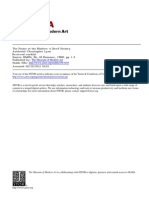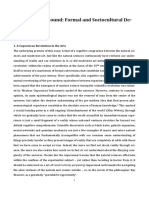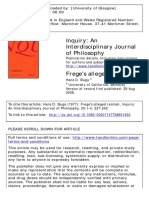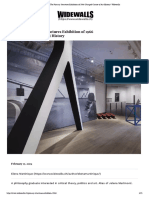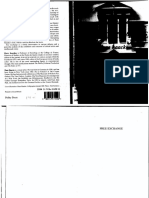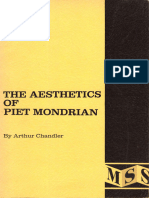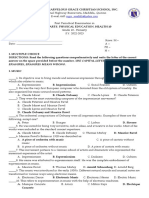Victor Vasarel
Victor Vasarel
Uploaded by
Karolina UrlikytėCopyright:
Available Formats
Victor Vasarel
Victor Vasarel
Uploaded by
Karolina UrlikytėOriginal Description:
Copyright
Available Formats
Share this document
Did you find this document useful?
Is this content inappropriate?
Copyright:
Available Formats
Victor Vasarel
Victor Vasarel
Uploaded by
Karolina UrlikytėCopyright:
Available Formats
Victor Vasarely (1906-1997)
Victor Vasarely was a Hungarian-French artist credited with having created the Op
Art movement. Vasarelys paintings and sculpture utilized geometrical shapes and
colorful graphics to create illusions of special depth on two-dimensional surfaces.
This abstract method of painting, also known as Kineticism, borrowed from a diverse
range of influences, including Bauhaus principles, Wassily Kandinskys abstraction,
and the Constructivist movement, which had a particularly significant impact on
Vasarelys practice. Born Vsrhelyi Gyozo on April 9, 1906 in Pcs, Hungary, the
artist originally studied medicine, but switched to painting after two years. Vasarely
enrolled in the Hungarian branch of the Bauhaus in Budapest in the late 1920s.
After settling in Paris in 1930, Vasarely worked as a graphic artist and developed his
signature abstract aesthetic.
Considered one of the progenitors of Op Art for his optically complex and illusionistic
paintings, Victor Vasarely spent the course of a long, critically acclaimed career
seeking, and arguing for, an approach to art making that was deeply social. He
placed primary importance on the development of an engaging, accessible visual
language that could be universally understoodthis language, for Vasarely, was
geometric abstraction, more commonly known as Op Art. Through precise
combinations of lines, geometric shapes, colors, and shading, he created eyepopping paintings, full of the illusion of depth, movement, and three-dimensionality.
More than pleasing tricks for the eye, Vasarely insisted, pure form and pure color
can signify the world.
Early Figuration (1935 1949)
Victor Vasarelys early works are essentially figure and nature based, and even
though he would refer this period of time as wrong ways or false routes. Most of
these drawings already contained the rudimentary elements of the optical and hight
structured geomatric themes that would eventually follow up.
Figure 1 Fille-Feur (1932)
Figure 2 "Sauzon" (1947)
Abstraction (1949 1954)
Inspired by the cracks on the titles of the walls of the Denfert-Rochreau metro
station in Paris, by the peculiar way in which glass breaks, and by the seemingly
haphazard manner in which the waves have shaped and organized the pebbles.
These works from the 1940s, early and mid 50s, compose the first coherent and
identifiable set of abstract works by the artist.
Figure 3"Ezinor" (1949)
Figure 4 "Banghor" (1954)
Zebras (1937 1950)
The Victor Vasarely Zebras are so rare, yet so widely reproduced! These beautiful
renditions of the black and white animal are truly the synthesis of the astists
creative journey from figure and nature to his trademark optical abstraction: the
bridge between the classical and the past-modern master.
Figure 5"Zbre" (1944)
Figure 6"Zbres" (1950)
Black & White (1953 1965)
The Black & White period is the groundbreaking, life changing turning point of Victor
Vararelys creative saga, the moment when he Hungarian expatriate defines the
artist we now know by the name of Vasarely. With these works he laid the
foundation of his captivating surface-defying metaphors and developed the basic
shapes.
Figure 7"Hommage Malevitch" (1953)
Figure 8 "Mandres" (1959)
Figure 9"Lux-Noavae" (1962)
Plastic Alphabet (1960 1980)
The creation of the Alphabet Plastique, literally a fine arts programming language,
is probably Victor Vasarelys greatest contribution of the history of art of the 20 th
century. Though these works he established the fundamental units, the unites
plastiques, the A, B, C of his new idiom derived from the basic elements of
geometry, the circle, the triangle, the square and their variantions that would be
matched to many different color scales of twenty hues each: fine arts software
providing infinite possibilities to the creative act.
Figure 10"Orion-K" (1972)
Figure 11"Hyram-Prism" (1980)
Gestalt and Vega (1969 1984)
Adding the spectacular element of three-dimensionality to the Alphabet Plastique
equation, the artist arrived at the impossible volumes that have become
synonymous to the Vasarely name.
Figure 12"Torony-Nagy" (1969)
Figure 13"Gestalt-Tri" (1978)
Figure 14"Vega-Multi" (1976)
Figure 15"Cosmos" (1984)
Bibliography:
http://www.op-art.co.uk/victor-vasarely/
http://www.vasarely-victor.com/
http://artist.christies.com/Victor-Vasarely--49122.aspx
http://www.fondationvasarely.fr/uk/vasarely4.php
http://www.artrepublic.com/biographies/260-victor-vasarely.html
https://www.masterworksfineart.com/artist/victor-vasarely/
You might also like
- Notes On Conceptual Architecture - Towards - Peter EisenmanDocument16 pagesNotes On Conceptual Architecture - Towards - Peter EisenmanSammy NguyenNo ratings yet
- Art Movements PPT SummaryDocument28 pagesArt Movements PPT SummaryamandaNo ratings yet
- Lyon - Poster at The Modern - Brief History - MoMA PDFDocument3 pagesLyon - Poster at The Modern - Brief History - MoMA PDFhofelstNo ratings yet
- Dillon Brian - Objects in This MirrorDocument1 pageDillon Brian - Objects in This MirrorfackprogramNo ratings yet
- Fool in Christ: Bruno Taut, Glass and Alpine ArchitectureDocument13 pagesFool in Christ: Bruno Taut, Glass and Alpine ArchitectureNathan BudzinskiNo ratings yet
- JodorowskyDocument15 pagesJodorowskykluckalicaNo ratings yet
- Hal Foster - Dailiness According To DemandDocument13 pagesHal Foster - Dailiness According To DemandGabino KimNo ratings yet
- Shakir Ali: "Art in Pakistan" BFA-IV (Visual Arts) Class Incharge: Ms. Farah Khan Institute of Design & Visual Arts, LCWUDocument25 pagesShakir Ali: "Art in Pakistan" BFA-IV (Visual Arts) Class Incharge: Ms. Farah Khan Institute of Design & Visual Arts, LCWUGane Sindhu100% (1)
- Thoughts On A Thinking "Model" of Antony Gormley: Recasting The History of SculptureDocument12 pagesThoughts On A Thinking "Model" of Antony Gormley: Recasting The History of SculptureLea ŠtambukNo ratings yet
- ARTICOLO - Anna Dezeuze, Tactile Dematerialization, Sensory Politics - Hélio Oiticica's ParangolésDocument15 pagesARTICOLO - Anna Dezeuze, Tactile Dematerialization, Sensory Politics - Hélio Oiticica's ParangolésPierre Le Torr100% (1)
- (A John Hope Franklin Center Book) Étienne Balibar, James Ingram-Equaliberty - Political Essays-Duke University Press Books (2014) PDFDocument375 pages(A John Hope Franklin Center Book) Étienne Balibar, James Ingram-Equaliberty - Political Essays-Duke University Press Books (2014) PDFCamilo Gallo GómezNo ratings yet
- Boulle eDocument17 pagesBoulle eLucio100No ratings yet
- Modernism UnboundDocument18 pagesModernism UnboundGerardo Meza GómezNo ratings yet
- Sluga, Hans D. Frege's Alleged Realism - 1977 PDFDocument18 pagesSluga, Hans D. Frege's Alleged Realism - 1977 PDFPablo BarbosaNo ratings yet
- Constructivism (Art) : BeginningsDocument7 pagesConstructivism (Art) : BeginningsNada De NadaNo ratings yet
- Crimp Douglas 1980 On The Museums RuinsDocument17 pagesCrimp Douglas 1980 On The Museums RuinsLourdes Correa CarloNo ratings yet
- Rereading SituationistsDocument13 pagesRereading SituationistsZie ChinaskiNo ratings yet
- Allen Weiss - Seeing The UnspeakableDocument8 pagesAllen Weiss - Seeing The UnspeakableadvocatearchitectureNo ratings yet
- Kaufmann Lessons of DebordDocument8 pagesKaufmann Lessons of DebordLefteris MakedonasNo ratings yet
- Week 3 - Part 1Document28 pagesWeek 3 - Part 1cusst.jackyhoonNo ratings yet
- Malevich Suprematism ManifestoDocument7 pagesMalevich Suprematism ManifestoSirma GenovaNo ratings yet
- Branden W. Joseph, White On WhiteDocument33 pagesBranden W. Joseph, White On WhiteJessica O'sNo ratings yet
- Rosalind Krauss No More Play1 PDFDocument46 pagesRosalind Krauss No More Play1 PDFAngyvir PadillaNo ratings yet
- Guy Debord - One More Try If You Want To Be Situationists (The S. I. in and Against Decomposition)Document5 pagesGuy Debord - One More Try If You Want To Be Situationists (The S. I. in and Against Decomposition)Ioana MacinicNo ratings yet
- Edgard Wind PDFDocument23 pagesEdgard Wind PDFMarcelo MarinoNo ratings yet
- The Semiotic Review of Books: AllagmaticDocument12 pagesThe Semiotic Review of Books: AllagmaticGuilherme Moura FagundesNo ratings yet
- Mark Godfrey Simon Starlings Regenerated SculptureDocument5 pagesMark Godfrey Simon Starlings Regenerated SculptureMahan JavadiNo ratings yet
- Art and Politics in The 20th CenturyDocument7 pagesArt and Politics in The 20th Centuryamars_aNo ratings yet
- David KakabadzeDocument4 pagesDavid KakabadzeGeorgian National MuseumNo ratings yet
- Nadar's Photographopolis - CadavaDocument23 pagesNadar's Photographopolis - CadavaJohannes de SilentioNo ratings yet
- Collective SingularsDocument26 pagesCollective Singularsluan_47No ratings yet
- David Leatherbarrow - Dalibor Vesely 1934-2015Document4 pagesDavid Leatherbarrow - Dalibor Vesely 1934-2015Orangejoe0% (1)
- Warburg and The Warburgian... Michael DiersDocument16 pagesWarburg and The Warburgian... Michael DiersanalauraiNo ratings yet
- The Local and The Global - Globalization and EthnicityDocument23 pagesThe Local and The Global - Globalization and EthnicityYve LeungNo ratings yet
- Rudolf Schindler, Dr. T.P. MArtin HouseDocument21 pagesRudolf Schindler, Dr. T.P. MArtin HousebsakhaeifarNo ratings yet
- All I Ez Osborne Adorno DeleuzeDocument15 pagesAll I Ez Osborne Adorno DeleuzefreakhermanNo ratings yet
- A Rose Has No TeethDocument1 pageA Rose Has No TeethBradshaw StanleyNo ratings yet
- Notes On The IndexDocument14 pagesNotes On The IndexRodrigo Arruda100% (1)
- HISTORY Watkin A History of Western ArchitectureDocument4 pagesHISTORY Watkin A History of Western ArchitectureZeinaAbouzeidNo ratings yet
- Criticas A PersepolisDocument9 pagesCriticas A PersepolisÁngel Horacio MolinaNo ratings yet
- Benjamin On Surrealism - The Last Snapshot of The European IntelligentsiaDocument8 pagesBenjamin On Surrealism - The Last Snapshot of The European IntelligentsiaScribdkidd123No ratings yet
- Educational Complex KelleyDocument25 pagesEducational Complex Kelleytemporarysite_orgNo ratings yet
- Whose Formalism - Art Bulletin 1996Document8 pagesWhose Formalism - Art Bulletin 1996Patricia Ciriani EspejoNo ratings yet
- Philip Pocock - With Reference To Hans HaackeDocument7 pagesPhilip Pocock - With Reference To Hans HaackePhilip PocockNo ratings yet
- Irit Rogoff Productive AnticipationDocument8 pagesIrit Rogoff Productive AnticipationRozenbergNo ratings yet
- Object, Relic, Fetish, ThingDocument17 pagesObject, Relic, Fetish, ThingchnnnnaNo ratings yet
- Race Time and Revision of Modernity - Homi BhabhaDocument6 pagesRace Time and Revision of Modernity - Homi BhabhaMelissa CammilleriNo ratings yet
- Joseph Beuys at The Guggenheim PDFDocument20 pagesJoseph Beuys at The Guggenheim PDFchnnnnaNo ratings yet
- Lectures by Gilles Deleuze - Theory of Multiplicities in BergsonDocument3 pagesLectures by Gilles Deleuze - Theory of Multiplicities in Bergsonbobo-gogoNo ratings yet
- Galinier, Jacques (Et - Al.), Anthropology of The Night. Cross-Disciplinary InvestigationsDocument30 pagesGalinier, Jacques (Et - Al.), Anthropology of The Night. Cross-Disciplinary InvestigationsHéctor ReyesNo ratings yet
- We Are All Flesh - BERLINDE DE BRUYCKEREDocument20 pagesWe Are All Flesh - BERLINDE DE BRUYCKEREFlavia FogliatoNo ratings yet
- 1 PB PDFDocument2 pages1 PB PDFCamila FigueiredoNo ratings yet
- List of Exhibited Works: Paintings and SculpturesDocument5 pagesList of Exhibited Works: Paintings and SculpturesBellingNo ratings yet
- Kiesler Rur Grey RoomDocument31 pagesKiesler Rur Grey Roominsulsus100% (1)
- StefanArteni TheScienceOfArtRevisedDocument496 pagesStefanArteni TheScienceOfArtRevisedstefan arteni100% (1)
- 3 Akira-Mizuta-Lippit-Atomic-Light-Shadow-OpticsDocument25 pages3 Akira-Mizuta-Lippit-Atomic-Light-Shadow-OpticscouppéNo ratings yet
- How The Primary Structures Exhibition of 1966 Changed Course of Art History - Widewalls PDFDocument15 pagesHow The Primary Structures Exhibition of 1966 Changed Course of Art History - Widewalls PDFAndreia MagalhaesNo ratings yet
- Ideology: Stronghold or Paradoxical Space? Michel PêcheuxDocument14 pagesIdeology: Stronghold or Paradoxical Space? Michel PêcheuxThales Medeiros100% (1)
- Pierre Bourdieu, Hans HaackeDocument78 pagesPierre Bourdieu, Hans HaackeClaudiaRomeroNo ratings yet
- WERCKMEISTER, O. K. Marx On Ideology and ArtDocument20 pagesWERCKMEISTER, O. K. Marx On Ideology and ArtpgcNo ratings yet
- Perspectives - Thesis Proposal OGRDocument10 pagesPerspectives - Thesis Proposal OGRKarolina UrlikytėNo ratings yet
- Perspectives - Proof of Concept PresentationsDocument16 pagesPerspectives - Proof of Concept PresentationsKarolina UrlikytėNo ratings yet
- From Script To Screen - OGR (Part 2) ScriptDocument5 pagesFrom Script To Screen - OGR (Part 2) ScriptKarolina UrlikytėNo ratings yet
- "What If? Metropolis" - OGR (Part1)Document9 pages"What If? Metropolis" - OGR (Part1)Karolina UrlikytėNo ratings yet
- What If Metropolis Final Crit PresentationDocument16 pagesWhat If Metropolis Final Crit PresentationKarolina UrlikytėNo ratings yet
- Invisible Cities ResearchDocument3 pagesInvisible Cities ResearchKarolina UrlikytėNo ratings yet
- Who's WhoDocument9 pagesWho's WhoKarolina UrlikytėNo ratings yet
- Invisible Cities - EsmeraldaDocument14 pagesInvisible Cities - EsmeraldaKarolina UrlikytėNo ratings yet
- Invisible Cities Esmeralda CritDocument32 pagesInvisible Cities Esmeralda CritKarolina UrlikytėNo ratings yet
- Kandinsky ArtDocument2 pagesKandinsky ArtBobby LyleNo ratings yet
- Tattoo Design - Exploring The Evolution of Tattoo Designs From Traditional To AbstractDocument5 pagesTattoo Design - Exploring The Evolution of Tattoo Designs From Traditional To AbstractMien HunNo ratings yet
- De StijlDocument22 pagesDe StijlSowmi MaheNo ratings yet
- HKWS1624 Reading Response 1Document2 pagesHKWS1624 Reading Response 1JessNo ratings yet
- Art Ap - Module 3Document7 pagesArt Ap - Module 3Rizza valenciaNo ratings yet
- Helen Frankenthaler LessonDocument1 pageHelen Frankenthaler Lessonapi-217242791No ratings yet
- Art Charles DemuthDocument2 pagesArt Charles Demuthapi-290457827No ratings yet
- Unit 4 Art App August 28Document14 pagesUnit 4 Art App August 28zennieebabyNo ratings yet
- 2024 BOW ARTS REVIEWER For EthanDocument39 pages2024 BOW ARTS REVIEWER For EthanRICHARD GUADALUPENo ratings yet
- Defining ArtDocument9 pagesDefining ArtHiledeNo ratings yet
- 1ST Arts 10 1Document19 pages1ST Arts 10 1Mr. ZeusNo ratings yet
- Lazlo Moholy Nagy MemorialDocument44 pagesLazlo Moholy Nagy MemorialMatilde AlgamizNo ratings yet
- Early 20 Century: ModernismDocument64 pagesEarly 20 Century: ModernismCruz LheoNo ratings yet
- Contemporary Art PracticesDocument2 pagesContemporary Art PracticesRodrick Sonajo RamosNo ratings yet
- Bridget Riley at The End of My Pencil LRB 8 October 2009Document5 pagesBridget Riley at The End of My Pencil LRB 8 October 2009Gagandeep Singh100% (1)
- Ferreira Gullar: Theory of The Non-ObjectDocument2 pagesFerreira Gullar: Theory of The Non-ObjectDiego Zorita ArroyoNo ratings yet
- Representational, Abstract, and Nonre Presentational Art: Key PointsDocument2 pagesRepresentational, Abstract, and Nonre Presentational Art: Key PointsDiana Jane GareNo ratings yet
- Objective Art. Representational or Non-Objective Art.: (Exaggerated Emotionalism)Document3 pagesObjective Art. Representational or Non-Objective Art.: (Exaggerated Emotionalism)Nicole Valerie DapanasNo ratings yet
- Arthur - Chandler - Modrian's Theory of ArtDocument68 pagesArthur - Chandler - Modrian's Theory of ArtVictor Hugo Loaiza SeguraNo ratings yet
- II. Philosophies and Functions of Art Subject and ContentDocument8 pagesII. Philosophies and Functions of Art Subject and ContentaerisseheartfillaNo ratings yet
- Artapp 103 Module 5 - Finding MeaningDocument12 pagesArtapp 103 Module 5 - Finding MeaningBerna QuiambaoNo ratings yet
- DecoupageDocument57 pagesDecoupageHara Vienna ClivaNo ratings yet
- DLL Arts 10 Q1-W3Document17 pagesDLL Arts 10 Q1-W3Robert ManiboNo ratings yet
- Reviewer in CparDocument3 pagesReviewer in CparMariela MendozaNo ratings yet
- Mapeh 10-ExamDocument6 pagesMapeh 10-ExamQueenie GamboaNo ratings yet
- Mapeh Grade 10Document3 pagesMapeh Grade 10Thalia Loreen Urmeneta RenonNo ratings yet
- Final Examination in Contemporary Philippine Arts Xii 3Document4 pagesFinal Examination in Contemporary Philippine Arts Xii 3Rhea Mae Tero100% (1)


